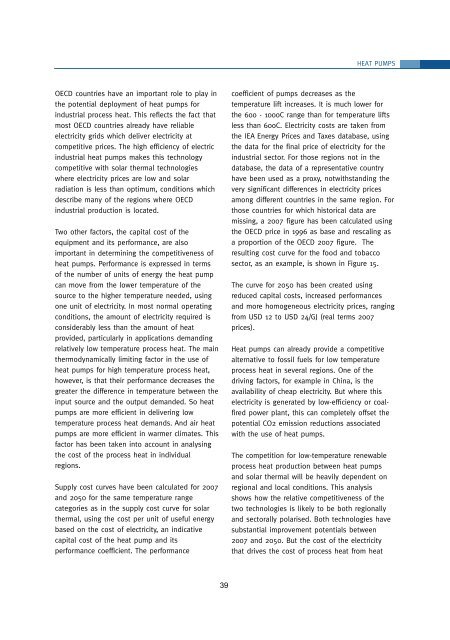Renewable Energy in Industrial Applications â an ... - Unido
Renewable Energy in Industrial Applications â an ... - Unido
Renewable Energy in Industrial Applications â an ... - Unido
Create successful ePaper yourself
Turn your PDF publications into a flip-book with our unique Google optimized e-Paper software.
HEAT PUMPS<br />
OECD countries have <strong>an</strong> import<strong>an</strong>t role to play <strong>in</strong><br />
the potential deployment of heat pumps for<br />
<strong>in</strong>dustrial process heat. This reflects the fact that<br />
most OECD countries already have reliable<br />
electricity grids which deliver electricity at<br />
competitive prices. The high efficiency of electric<br />
<strong>in</strong>dustrial heat pumps makes this technology<br />
competitive with solar thermal technologies<br />
where electricity prices are low <strong>an</strong>d solar<br />
radiation is less th<strong>an</strong> optimum, conditions which<br />
describe m<strong>an</strong>y of the regions where OECD<br />
<strong>in</strong>dustrial production is located.<br />
Two other factors, the capital cost of the<br />
equipment <strong>an</strong>d its perform<strong>an</strong>ce, are also<br />
import<strong>an</strong>t <strong>in</strong> determ<strong>in</strong><strong>in</strong>g the competitiveness of<br />
heat pumps. Perform<strong>an</strong>ce is expressed <strong>in</strong> terms<br />
of the number of units of energy the heat pump<br />
c<strong>an</strong> move from the lower temperature of the<br />
source to the higher temperature needed, us<strong>in</strong>g<br />
one unit of electricity. In most normal operat<strong>in</strong>g<br />
conditions, the amount of electricity required is<br />
considerably less th<strong>an</strong> the amount of heat<br />
provided, particularly <strong>in</strong> applications dem<strong>an</strong>d<strong>in</strong>g<br />
relatively low temperature process heat. The ma<strong>in</strong><br />
thermodynamically limit<strong>in</strong>g factor <strong>in</strong> the use of<br />
heat pumps for high temperature process heat,<br />
however, is that their perform<strong>an</strong>ce decreases the<br />
greater the difference <strong>in</strong> temperature between the<br />
<strong>in</strong>put source <strong>an</strong>d the output dem<strong>an</strong>ded. So heat<br />
pumps are more efficient <strong>in</strong> deliver<strong>in</strong>g low<br />
temperature process heat dem<strong>an</strong>ds. And air heat<br />
pumps are more efficient <strong>in</strong> warmer climates. This<br />
factor has been taken <strong>in</strong>to account <strong>in</strong> <strong>an</strong>alys<strong>in</strong>g<br />
the cost of the process heat <strong>in</strong> <strong>in</strong>dividual<br />
regions.<br />
Supply cost curves have been calculated for 2007<br />
<strong>an</strong>d 2050 for the same temperature r<strong>an</strong>ge<br />
categories as <strong>in</strong> the supply cost curve for solar<br />
thermal, us<strong>in</strong>g the cost per unit of useful energy<br />
based on the cost of electricity, <strong>an</strong> <strong>in</strong>dicative<br />
capital cost of the heat pump <strong>an</strong>d its<br />
perform<strong>an</strong>ce coefficient. The perform<strong>an</strong>ce<br />
coefficient of pumps decreases as the<br />
temperature lift <strong>in</strong>creases. It is much lower for<br />
the 60o - 100oC r<strong>an</strong>ge th<strong>an</strong> for temperature lifts<br />
less th<strong>an</strong> 60oC. Electricity costs are taken from<br />
the IEA <strong>Energy</strong> Prices <strong>an</strong>d Taxes database, us<strong>in</strong>g<br />
the data for the f<strong>in</strong>al price of electricity for the<br />
<strong>in</strong>dustrial sector. For those regions not <strong>in</strong> the<br />
database, the data of a representative country<br />
have been used as a proxy, notwithst<strong>an</strong>d<strong>in</strong>g the<br />
very signific<strong>an</strong>t differences <strong>in</strong> electricity prices<br />
among different countries <strong>in</strong> the same region. For<br />
those countries for which historical data are<br />
miss<strong>in</strong>g, a 2007 figure has been calculated us<strong>in</strong>g<br />
the OECD price <strong>in</strong> 1996 as base <strong>an</strong>d rescal<strong>in</strong>g as<br />
a proportion of the OECD 2007 figure. The<br />
result<strong>in</strong>g cost curve for the food <strong>an</strong>d tobacco<br />
sector, as <strong>an</strong> example, is shown <strong>in</strong> Figure 15.<br />
The curve for 2050 has been created us<strong>in</strong>g<br />
reduced capital costs, <strong>in</strong>creased perform<strong>an</strong>ces<br />
<strong>an</strong>d more homogeneous electricity prices, r<strong>an</strong>g<strong>in</strong>g<br />
from USD 12 to USD 24/GJ (real terms 2007<br />
prices).<br />
Heat pumps c<strong>an</strong> already provide a competitive<br />
alternative to fossil fuels for low temperature<br />
process heat <strong>in</strong> several regions. One of the<br />
driv<strong>in</strong>g factors, for example <strong>in</strong> Ch<strong>in</strong>a, is the<br />
availability of cheap electricity. But where this<br />
electricity is generated by low-efficiency or coalfired<br />
power pl<strong>an</strong>t, this c<strong>an</strong> completely offset the<br />
potential CO2 emission reductions associated<br />
with the use of heat pumps.<br />
The competition for low-temperature renewable<br />
process heat production between heat pumps<br />
<strong>an</strong>d solar thermal will be heavily dependent on<br />
regional <strong>an</strong>d local conditions. This <strong>an</strong>alysis<br />
shows how the relative competitiveness of the<br />
two technologies is likely to be both regionally<br />
<strong>an</strong>d sectorally polarised. Both technologies have<br />
subst<strong>an</strong>tial improvement potentials between<br />
2007 <strong>an</strong>d 2050. But the cost of the electricity<br />
that drives the cost of process heat from heat<br />
39

















